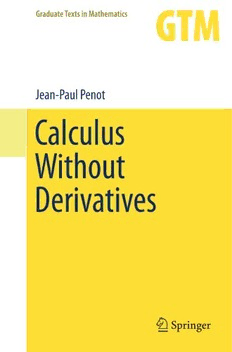
Calculus without derivatives PDF
Preview Calculus without derivatives
Graduate Texts in Mathematics 266 Graduate Texts in Mathematics SeriesEditors: SheldonAxler SanFranciscoStateUniversity,SanFrancisco,CA,USA KennethRibet UniversityofCalifornia,Berkeley,CA,USA AdvisoryBoard: ColinAdams,WilliamsCollege,Williamstown,MA,USA AlejandroAdem,UniversityofBritishColumbia,Vancouver,BC,Canada RuthCharney,BrandeisUniversity,Waltham,MA,USA IreneM.Gamba,TheUniversityofTexasatAustin,Austin,TX,USA RogerE.Howe,YaleUniversity,NewHaven,CT,USA DavidJerison,MassachusettsInstituteofTechnology,Cambridge,MA,USA JeffreyC.Lagarias,UniversityofMichigan,AnnArbor,MI,USA JillPipher,BrownUniversity,Providence,RI,USA FadilSantosa,UniversityofMinnesota,Minneapolis,MN,USA AmieWilkinson,UniversityofChicago,Chicago,IL,USA Graduate Texts in Mathematics bridge the gap between passive study and creative understanding, offering graduate-level introductions to advanced topics in mathematics. The volumes are carefully written as teaching aids and highlight characteristic features of the theory. Although these books are frequently used as textbooksingraduatecourses,theyarealsosuitableforindividualstudy. Forfurthervolumes: http://www.springer.com/series/136 Jean-Paul Penot Calculus Without Derivatives 123 Jean-PaulPenot LaboratoireJacques-LouisLions Universite´PierreetMarieCurie Paris,France ISSN0072-5285 ISBN978-1-4614-4537-1 ISBN978-1-4614-4538-8(eBook) DOI10.1007/978-1-4614-4538-8 SpringerNewYorkHeidelbergDordrechtLondon LibraryofCongressControlNumber:2012945592 MathematicsSubjectClassification(2010):49J52,49J53,58C20,54C60,52A41,90C30 ©SpringerScience+BusinessMediaNewYork2013 Thisworkissubjecttocopyright.AllrightsarereservedbythePublisher,whetherthewholeorpartof thematerialisconcerned,specificallytherightsoftranslation,reprinting,reuseofillustrations,recitation, broadcasting,reproductiononmicrofilmsorinanyotherphysicalway,andtransmissionorinformation storageandretrieval,electronicadaptation,computersoftware,orbysimilarordissimilarmethodology nowknownorhereafterdeveloped.Exemptedfromthislegalreservationarebriefexcerptsinconnection with reviews or scholarly analysis or material supplied specifically for the purpose of being entered and executed on a computer system, for exclusive use by the purchaser of the work. Duplication of this publication or parts thereof is permitted only under the provisions of the Copyright Law of the Publisher’slocation,initscurrentversion,andpermissionforusemustalwaysbeobtainedfromSpringer. PermissionsforusemaybeobtainedthroughRightsLinkattheCopyrightClearanceCenter.Violations areliabletoprosecutionundertherespectiveCopyrightLaw. Theuseofgeneraldescriptivenames,registerednames,trademarks,servicemarks,etc.inthispublication doesnotimply,evenintheabsenceofaspecificstatement,thatsuchnamesareexemptfromtherelevant protectivelawsandregulationsandthereforefreeforgeneraluse. While the advice and information in this book are believed to be true and accurate at the date of publication,neithertheauthorsnortheeditorsnorthepublishercanacceptanylegalresponsibilityfor anyerrorsoromissionsthatmaybemade.Thepublishermakesnowarranty,expressorimplied,with respecttothematerialcontainedherein. Printedonacid-freepaper SpringerispartofSpringerScience+BusinessMedia(www.springer.com) To thememoryof myparents, withthehopethattheir thirst forcultureand knowledge willbetransmitted tothereader throughthisbook Preface AfamousIndiansayingcanbeapproximativelyphrasedinthefollowingway:“Our earthisnotjustalegacyfromourparents;itisaloanfromourchildren.” In mathematical analysis, a precious legacy has been given to us: differential calculusandintegralcalculusaretoolsthatplayanimportantroleinthepresentstate ofknowledgeandtechnology.Theyevengaverisetoaphilosophicalopinion,often calleddeterminism,thatamountstosayingthatanyphenomenoncanbepredicted, providedoneknowsitsrulesandtheinitialconditions.Suchatriumphantclaimhas beenmitigatedbymoderntheoriessuchasquantummechanics.The“fuzziness”one meetsinthisbookpresentssomeanalogywithmodernmechanics.Insomesense, itisthebestwecanleavetoourchildrenincasetheyhavetodealwithroughdata. Inthemiddleofthenineteenthcentury,Weierstrassmadeclearthefactthatnot allfunctionsaredifferentiable.Heevenprovedthattherearecontinuousfunctionsof onerealvariablethatarenowheredifferentiable.Althoughsuch“exotic”functions arenotnegligible,itappearsthatmostnonsmoothfunctionsthataremetinconcrete mathematicalproblemshaveabehaviorthatisnotbeyondthereachofanalysis. It is the purpose of the present book to show that an organized bundle of knowledgecanbeappliedtosituationsinwhichdifferentiabilityisnotpresent. Infavorablecases,suchaspointwisemaximaoffinitefamiliesofdifferentiable functionsorsumsofconvexfunctionswithdifferentiablefunctions,arathersimple apparatus allows us to extend in a unified way the rules known in the realms of convex analysis and differentiable analysis. The pioneers in this restricted framework were Pshenichnii, Ioffe, and Tikhomirov (and later on, Demy’anov, Janin, among others). For general functions, more subtle constructions must be devised. Already at this elementary stage, a combination of geometrical and analytical viewpoints gives greater and more incisive insight. Such a unified viewpoint is one of the revolutionary characteristics of nonsmooth analysis: functions, sets, mappings,andmultimappings(orcorrespondences)canbeconsideredtobeequally important, and the links between them allow us to detect fruitful consequences. Historically, geometrical concepts (tangent and normal cones with Bouligand, Severi,Choquet,Dubovitskii-Milyutin,...)appearedearlierthananalyticalnotions vii viii Preface (generalized directional derivatives, subdifferentials with Clarke, Ioffe, Kruger, Mordukhovich,...). On the other hand, the variety of situations and needs has led to different approaches. In our opinion, it would not be sensible to leave the reader with the impressionthatasingletypeofanswerorconstructioncanmeetalltheneedsone mayencounter(itisnoteventhecasewithsmoothcalculus).Itisourpurposetogive thereadertheabilitytochooseanappropriateschemedependingonthespecificities oftheproblemathand.Quiteoften,theproblemitselfleadstoanadaptedspace.In turn, the space often commandsthe choice of the subdifferentialas a manageable substituteforthederivative. In this book we endeavorto present a balancedpicture of the most elementary attempts to replace a derivative with a one-sided generalized derivative called a subdifferential.Thismeansthatinsteadofassociatingalinearformtoafunctionat somereferencepointinordertosummarizesomeinformationaboutthebehaviorof thefunctionaroundthatpoint,oneassociatesabunchoflinearforms.Ofcourse,the usefulnessofsuchaprocessreliesontheaccuratenessoftheinformationprovided by such a set of linear forms. It also relies on the calculus rules one can design. Thesetworequirementsappearto besomewhatantagonistic.Therefore,itmaybe worthwhile to dispose of various approaches satisfying at least one of these two requirements. Inspiteofthevarietyofapproaches,wehopethatourpresentationherewillgive an impression of unity. We do not consider the topic as a field full of disorder. On the contrary, it has its own methods, and its various achievements justify a comprehensive approach that has not yet been presented. Still, we do not look for completeness; we rather prefer to present significant tools and methods. The references,notes,exercises,andsupplementswepresentwillhelpthereadertoget amorethoroughinsightintothesubject. Inwritingabook,onehastofaceadelicatechallenge:eitherfollowatraditionor prepareforamorerigoroususe.Ourexperiencewithtextsthatwerewrittenabout a lifetime ago showed us that the need for rigor and precision has increased and is likely to increase more. Thus, we have avoided some common abuses such as confusingafunctionwithitsvalue,a sequencewithitsgeneralterm,a spacewith its dual, the gradient of a function with its derivative, the adjoint of a continuous linearmapwithitstranspose.Thatchoicemayleadtounusualexpressions.Butin general, we have made efforts to reach as much simplicity as possible in proofs, terminology and notation, even if some proofs remain long. Moreover, we have preferred suggestive names (such as allied, coherence, gap, soft) to complicated expressions or acronyms, and we have avoided a heavy use of multiple indices, of Greek letters (and also of Cyrillic, Gothic, Hebrew fonts). It appearsto us that sophisticated notation blossoms when the concepts are fresh and still obscure; as soonastheconceptsappearasnaturalandsimple,thenotationtendstogetsimpler too. Of course, besides mathematicians who are attached to traditions, there are someotherswhoimplicitlypresentthemselvesasmagiciansorlearnedpeopleand liketokeepsophisticatednotation. Preface ix Let us present in greater detail the analysis that served as a guideline for this book. Thefieldofmathematicsoffersa numberoftopicspresentingbeautifulresults. However, many of them are rather remote from practical applications. This fact makes them not too attractive to many students. Still, they are proposed in many coursesbecausetheyareconsideredeitherasimportantfromatheoreticalviewpoint orpreciousfortheformationofminds. Itisthepurposeofthisbooktopresentfundamentalaspectsofanalysisthathave close connections with applications. There is no need to insist on the success of analysis. So manyachievementsof moderntechnologyrely on methodsor results from mathematical analysis that it is difficult to imagine what our lives would be like if the consequencesofthe so-calledinfinitesimalanalysisof Fermat,Leibniz, Newton,Eulerandmanyotherswouldbewithdrawnfromus. However, the classical differential calculus is unable to handle a number of problems in which order plays a key role; J.-J. Moreau called them “unilateral problems,” i.e., one-sided problems. Usually, they are caused by constraints or obstacles. A few decades ago, some tools were designed to study such problems. They are applied in a variety of fields, such as economics, mechanics, optimization, numericalanalysis,partialdifferentialequations.Webelievethatthisrichspectrum of applications can be attractive for the reader and deserves a sequel to this book with complementary references, since here we do not consider applications as importantas those in optimal control theory and mathematicalanalysis. Also, we do not consider special classes of functions or sets, and we do not even evoke higher-ordernotions,althoughconsideringsecond-ordergeneralizedderivativesof nondifferentiablefunctionscanbeconsideredafeat! Besides some elements of topology and functional analysis oriented to our needs,wegatherherethreeapproaches:differentialcalculus,convexanalysis,and nonsmooth analysis. The third of these is the most recent, but it is becoming a classicaltopicencompassingthefirsttwo. The novelty of a joint presentation of these topics is justified by several arguments.Firstofall,sincenonsmoothanalysisencompassesbothconvexanalysis anddifferentialcalculus,itisnaturaltopresentthesetwosubjectsasthetwobasic elementsonwhichnonsmoothanalysisisbuilt.Theybothserveasanintroduction to the newest topic. Moreover, they are both used as ingredients in the proofs of calculusrulesinthenonsmoothframework.Ontheotherhand,nonsmoothanalysis representsan incentive to enrich convexanalysis (and maybe differentialcalculus too, as shown here by the novelty of incorporating directional smoothness in the approach).Asanexample,wementiontherelationshipbetweenthesubdifferential of the distance function to a closed convex set C at some point z out of C and the normalcone to the setC at pointsofC that almostminimize the distance to z (Exercises6and7ofSect.7.1ofthechapteronconvexanalysis).Anotherexample isthefuzzycalculusthatiscommontoconvexanalysisandnonsmoothanalysisand waspromptedbythelastdomain.
